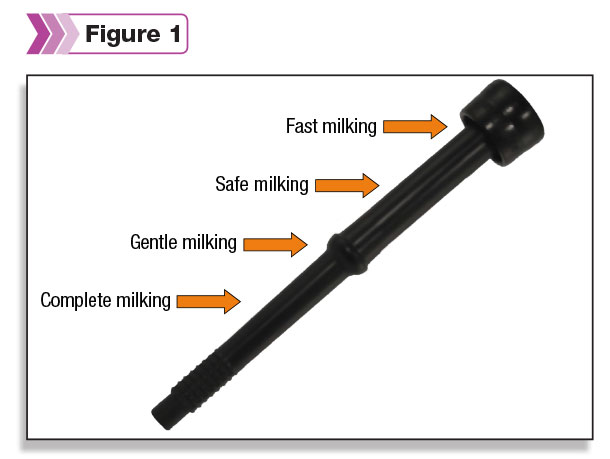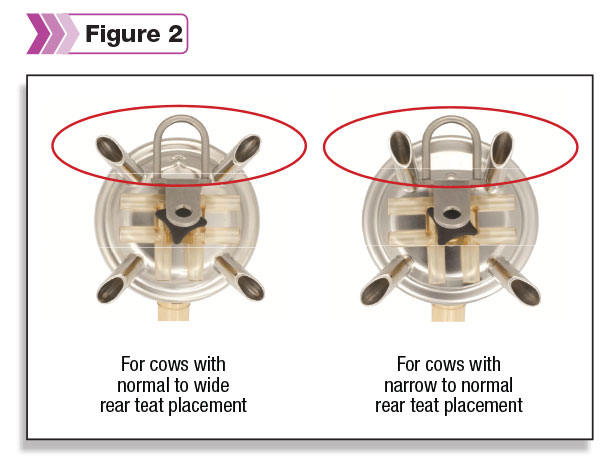Milking systems are designed to collect milk effectively and efficiently, with the cow’s comfort in mind. Perhaps the most important, and often overlooked, part of the system is the teat cup liner.
Teat cup liners are just like tires; they need to be changed regularly to ensure proper performance. But how do you know when to change liners? There are hundreds of varieties in use today, and each one comes with the manufacturer’s recommendations for use – some based on milking hours and some on number of milkings.
But manufacturers’ guidelines are just that – guidelines. It still takes diligence and keen observation on the part of the operator to ensure efficiency and comfort. Everyone wants to get their money’s worth, with performance and cow comfort balanced against liner longevity.
What works?
Optimal cow milking is a balancing act of several elements. Teat health, proper milk flow, complete milkout, liner slips and minimal unit-on time all contribute to the ultimate goal – fast, safe, gentle and complete milking.

Getting the best use from your milking equipment begins with selecting the right liner that is matched for your operation, system settings and your cows.
Both rubber and silicone liners have advantages. Rubber liners are less expensive up-front compared to the silicone variety, although the cost per milking calculated over time may not be significant. Rubber is a more durable material, with greater resistance to cuts.
They deteriorate faster but can be a viable option for dairies in need of a robust compound.
Silicone liners have a longer life and improved surfaces. They are less prone to deterioration and cracking, as they hold up better against butterfat in the milk. But even high-quality silicone will eventually succumb to cleaning chemicals and hot water.
The key is a product that will maintain consistent milkability throughout its use life.

Using the right shape and size for the cows in your herd is crucial. Various shapes massage teats differently, with new designs hitting the market with regularity. There are also vented options that help quickly move milk away from the teat end and into the claw during peak milk flow.
And pay attention to teat size. Liners come in a multitude of mouthpiece diameters, barrel lengths and short milk tube designs. A liner that is too large or too small for the herd will not only be uncomfortable but ineffective.
Whatever product you choose, be sure to consult your milking equipment company representative or milk quality specialist for initial setup, as well as ongoing adjustments. Every liner needs to be matched with the appropriate vacuum, pulsation and takeoff settings.
Replacing liners
If there is an improvement in milking performance when the liners are changed, it is a sign they are being changed too late. Visual signs of deterioration should lead to immediate liner replacement. If a liner is cracked or torn, it is long past its usefulness.
However, oftentimes, liner deterioration signs are invisible to the naked eye, making them difficult to detect and, as a result, we have to look at other cues.
Liners should milk the cow with minimal discomfort to the teats. Adequately massaged teats should feel soft and not swollen when the cup is removed. Discoloration of teats after milking is a sign of inaccurate vacuum or pulsation settings, or poor liner function. A liner that does not correctly compress on the teat will not reduce fluids that accumulate near the teat end during the milking phase.
This can lead to congestion of the teat canal, restricting the downward flow of milk. When liners are not changed on proper intervals, the mouthpiece and barrel become distorted, causing poor massaging of the teat, which is often combined with an increase in liner slips.
This, overall, results in an inefficient and ineffective milking performance on your herd.
Efficient milking is desired, and essential, for the dairy operation. There are key performance indicators influenced by liners which can be monitored to determine performance. Here are a few to keep an eye on:
- Peak milk flow should be 8 to 12 pounds per minute within the first two minutes on 80 percent of the cows.
- Average milk flow of 6.5 to 8.5 pounds per minute is desired on more than 80 percent of the cows.
- Teat color change, red or blue, should occur on less than 10 percent of the teats.
- Quarters should milk out evenly within 1.5 minutes of each other on 90 percent of the cows.
- Teat-end scores of 1 and 2 (healthy teat ends) are desired on at least 80 percent of teats.
- Liner slips should be less than 2 percent of the quarters milked.
As tempting as it may be to eke out extra milkings from the liners, you never want to sacrifice performance or cow health.
Is that all?
Choosing the correct liner and paying close attention to liner maintenance and system settings will lead to peak performance, but there is more. Claw selection also influences performance. The claw bowl should be large enough to handle the peak flow rate from all four liners combined without flooding. A backup of milk will affect vacuum pressure and therefore affect performance.
The same goes for milklines. Any restrictions in the milk path, whether it be a loop in the line, worn hoses or designs that work against gravity, will restrict vacuum and milk flow.
Be sure to check all parts of the system, whether doing routine maintenance or when experiencing performance problems. Consult your milking equipment specialist for guidance on any part of your system. He or she should be involved in any equipment change, including new liners, as well as performing monthly or quarterly system checks.
Teat cup liners are the only part of the milking system that comes in direct contact with the cow’s teat tissue. Many dairy farmers assume teat problems or cows kicking and dancing are normal for every operation.
But that is not the case. They are signs the milking system is not working properly and a change is needed. Don’t fear making the proper adjustments. It may be a simple as replacing your liners. PD

-
Rob LeViere
- Liner Sales Specialist
- GEA
- Email Rob LeViere






